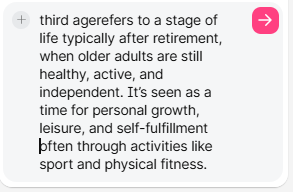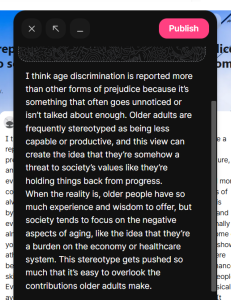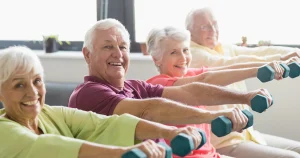6
Section One: The Fundamentals
A) Keywords
Exercise 1:
Provide a brief definition of one of the padlet keywords for this week.

|
B) The Social Significance of Aging in Sport
Exercise 2: Notebook Prompt
How is old age popularly represented today? Find an image online that you think exemplifies one defining attitude towards old age and paste in your notebook below with a brief explanation of what this image means to you.
| Old age today is often shown in two main ways: either as super frail and dependent, or as the “super senior” who’s climbing mountains and never sitting at 90. To me, this image depict an old, frail man reaching out to a younger, stronger person. It looks like it was drawn a long time ago, and it really captures one of the most common ideas about aging that older people are weak, dependent, and in need of help from the young. To me, this image reflects how society often sees aging as a time of decline, which can be kind of sad and limiting. It makes me think about how we need more diverse and empowering ways to represent aging not just as something to be pitied or fixed.
|
Exercise 3: Notebook Prompt
What does the article (referencing another study by Dionigi) mean by its statement that sport can help aging people to simultaneously “accept and resist the ageing process” (572)? Respond by audio or text and find paste two images sourced online into your notebook showing how sport might help aging people to both accept and resist the aging process.
| In Rylee Dionigi’s research, she discusses how sport enables older adults to both “accept and resist the aging process.” By participating in sports, individuals acknowledge the natural aging process by accepting that their bodies change over time. However, through consistent training and competition, they also challenge age-related limitations, resisting the decline often associated with aging. This dual approach fosters a sense of empowerment, allowing older adults to maintain autonomy and well-being.
This image represents the aspect of “resisting” the aging process. The senior athlete actively participates in competitive sports, demonstrating that age does not preclude high performance and challenging societal expectations of aging.
This image highlights the “acceptance” aspect. Older adults participating in group exercises acknowledge the importance of physical activity in maintaining health and well-being, embracing the aging process through communal engagement and support. These images collectively illustrate how sport serves as a means for older adults to navigate aging, balancing acceptance with resistance to decline. |
Exercise 4: Notebook Prompt
Who are the groups less likely to have extensive opportunities to take part in sports, according to Pike? How does privilege factor into aging and sport? (200 words max)
| According to Pike, the groups less likely to have extensive opportunities to take part in sports include people from lower socioeconomic backgrounds, racialized communities, women, and those with disabilities. These groups often face barriers like lack of access to facilities, equipment, transportation, or supportive environments. When it comes to aging, privilege plays a big role in who gets to stay active. For example, older adults with more financial resources can afford gym memberships, travel to events, or buy proper gear, while others might not even have a safe place to walk in their neighborhood.
|
Exercise 5: Padlet Discussion
Why do you think age discrimination is “reported more than any form of prejudice” with older people presented as a threat to social values and interests? Feel welcome to use video in your responses. Paste your comments (or transcript of your video) below!

|
B) Older Women and Sport
Exercise 6: Notebook Prompt
What differences do you see in these ads? Which one is more inclusive? How is age represented or not represented in each? Answer these questions in your notebook.
| In comparing the two ads, Nike “You Can’t Stop Us” and This Girl Can, the attitudes toward aging in sport differ significantly. Nike’s ad focuses on resilience and perseverance, portraying athletes of various abilities and backgrounds but without explicitly addressing age. It suggests that age doesn’t limit one’s ability to overcome challenges, though it doesn’t highlight older athletes. On the other hand, This Girl Can makes a conscious effort to include women of different ages, particularly older women, showing that physical activity and sports are for everyone, regardless of age or fitness level. This ad challenges societal stereotypes around aging and sports, promoting the idea that it’s never too late to be active. In this way, This Girl Can is more inclusive in addressing aging, encouraging women to embrace their bodies and stay active at any stage of life, while Nike’s ad focuses more on general resilience and overcoming obstacles, without directly confronting age.
|
Exercise 7: Notebook Prompt
In her article, “Assessing the sociology of sport: On age and ability,” Elizabeth Pike references a “trend towards a ‘feminisation of ageing’, with many women living longer than men” (573). Do you agree that aging has been “feminized” in this way? How? Answer these questions in your notebook.
| Yes, I agree that aging has been “feminized” in the way Elizabeth Pike describes. The trend refers to how women, on average, tend to live longer than men, which affects how aging is portrayed and experienced. As more women live into older age, the challenges and stereotypes associated with aging have become more visible in the context of women’s health, appearance, and social roles. This “feminization” of aging is evident in media portrayals where older women are often depicted as fragile, needing care, or battling to maintain youthfulness, while men are less frequently subject to the same scrutiny. There’s a societal expectation for women to age gracefully, and much of the focus is on maintaining beauty, fitness, and health. This results in pressure on older women to defy aging, while men are often allowed to age without facing the same level of judgment or societal expectations. In terms of sports, this plays out in how older women may feel less encouraged or supported to stay active as they age, compared to men, who are more often shown as remaining involved in sports later in life. The “feminization” of aging, therefore, both reflects and reinforces gendered expectations about how we view aging and physical activity for different genders.
|
Section Three: Module Mini Assignment
| I chose to do this as the main project!
|



